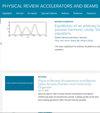具有均匀空间轮廓的激光驱动高能质子束来自纳米球靶
Physical Review Special Topics-accelerators and Beams
Pub Date : 2015-07-10
DOI:10.1103/PHYSREVSTAB.18.071304
引用次数: 42
摘要
用短(30-fs)强($7\ifmmode\times\else\texttimes\fi{}{10}^{20}\text{}\text{}\mathrm{W}/{\mathrm{cm}}^{2}$)激光脉冲照射纳米球靶,产生了具有良好均匀轮廓的高能、高产能质子束。在5—30 MeV的能量范围内,质子数高达$7\ifmmode\times\else\texttimes\fi{}{10}^{10}$,最大质子能量为30 MeV。在纳米球介质靶上观测到均匀性(85%波束面积内平均值的标准差)为15%的均匀空间剖面。粒子池模拟结果表明,纳米球靶增强了质子的截止能量和质子数,并揭示了均匀的光束分布与纳米球结构引起的热电子角分布的扩大有关。利用纳米球靶获得的均匀空间特性将有利于开发高质量光束的激光驱动质子源。本文章由计算机程序翻译,如有差异,请以英文原文为准。
Laser-driven high-energy proton beam with homogeneous spatial profile from a nanosphere target
A high-energy, high-yield proton beam with a good homogeneous profile has been generated from a nanosphere target irradiated by a short (30-fs), intense ($7\ifmmode\times\else\texttimes\fi{}{10}^{20}\text{ }\text{ }\mathrm{W}/{\mathrm{cm}}^{2}$) laser pulse. A maximum proton energy of 30 MeV has been observed with a high proton number of $7\ifmmode\times\else\texttimes\fi{}{10}^{10}$ in the energy range 5--30 MeV. A homogeneous spatial profile with a uniformity (standard deviation from an average value within 85% beam area) of 15% is observed with the nanosphere dielectric target. Particle-in-cell simulations show the enhancement of proton cutoff energy and proton number with the nanosphere target and reveal that the homogeneous beam profile is related with a broadened angular distribution of hot electrons, which is initiated by the nanosphere structure. The homogeneous spatial properties obtained with the nanosphere target will be advantageous in developing laser-driven proton sources for practical applications in which high-quality beams are required.
求助全文
通过发布文献求助,成功后即可免费获取论文全文。
去求助
来源期刊
自引率
0.00%
发文量
0
审稿时长
3-8 weeks
期刊介绍:
Physical Review Special Topics - Accelerators and Beams (PRST-AB), is a peer reviewed, purely electronic journal, distributed without charge to readers and funded by contributions from national laboratories. It covers the full range of accelerator science and technology: subsystem and component technologies, beam dynamics; accelerator applications; and design, operation, and improvement of accelerators used in science and industry. This includes accelerators for high-energy and nuclear physics, synchrotron radiation production, spallation neutron sources, medical therapy, and intense beam applications.

 求助内容:
求助内容: 应助结果提醒方式:
应助结果提醒方式:


